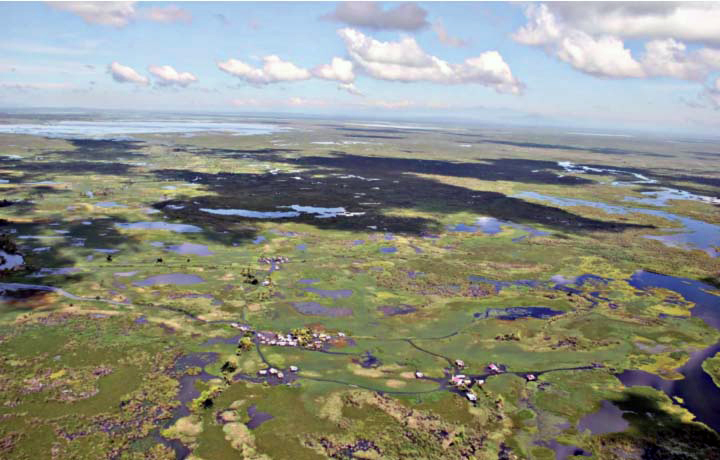Liguasan Marsh, located in Southern Mindanao, is the largest Marsh wetland in the Philippines, covering over 220,000 hectares, spread across the provinces of Maguindanao, Cotabato, and Sultan Kudarat. It is a conglomeration of three marshes: Liguasan Marsh proper, Libungan Marsh, and the Ebpanan Marsh. A marsh is a tract of soft wetland characterised by grasses and cattails (Monocotyledons), which are tall reedy marsh plants with brown furry spikes. Giant Reed plants (Typhoon Latifolia) with long flat leaves abound and are used especially for making native mats and chair seats. The Muslim people have been laying claim to Maguindanao and North Cotabato as part of their ancestral domain.
The Luwaran Editorial Desk stated on 9-April-2017, “It is good news to hear that the Duterte administration is pouring at least Php21 million for the planting of bamboo and mangroves in the Liguasan Marsh. By modest standards, the money is too small but as a starting point, it is more than enough.”
Rene Acosta reported on 24-June-2018 on Business Mirror, The Terrain, “According to Military Public Affairs chief Col. Noel Detoyato, the marshland is very fertile for planting crops, which makes it “very inviting” for civilian habitation. The rich patches of lands of Liguasan grow one of the best varieties of corn and rice in the country, with the villagers cultivating what is locally called as Tapul or Denorado for avid staple consumers.”
Several rare palms, orchids and ferns like the Water Hyacinth (Eichhornia crassipes); Anahau Palm (Livistona rotundifolia); Buri Palm (Corypha elata); Nipa Palm (Nypa fruticans); Areca Nut (Areca catechu); Screw Pine (Pandanus tectorious); Sweet Flag (Calamus mallis); Bird’s Nest Fern (Asplenium ridus); and Oak Leaf Fern (Drynaria quercifolia) are found in Liguasan because of the rich freshwater from the Marsh.
About 30,000 hectares are designated as a game refuge and bird sanctuary. Liguasan Marsh is “seen to have great potential for eco-tourism as it is home to rare birds that can only be found in the Marsh,” according to Emelie Jamorabon, Tourism Officer, Tacurong City. A Mindanao endemic subspecies of water birds, the vulnerable Philippine Duck (Anas luzonica) and the Little Grebe (Tachybaptus Ruficollis cotabaco), as well as the Comb-crested Jacana (Irediparra gallinacea), are all endemic to Liguasan Marsh. The Jacana is also known as the Lotus Bird or the Lillytrotter Bird, because it walks above the water surface by leaping on leaves of water lilies. The Marsh also serves as a nesting place of the famous Philippine Monkey-eating Eagle (Pithecophaga jeffery).
Of the 31 fish species collected, 19 (65%) are native, composed of cyprinid, goby, catfish, gourami, eel, banak, climbing perch, gilli, pigek, and jack. A serious fishery undertaking at Liguasan Marsh is culturing Tilapia and fattening up Mudfish. The Philippine Crocodile (Crocodylus mindorensis), which is endangered, as well as the larger Estuarine Crocodile or Saltwater Crocodile (Crocodylus porosus) have made the Marsh their home. Losing these rare, endangered species to extinction also means the world losing a precious biological heritage.
Liguasan Marsh is also thought to hold large reserves of oil and natural gas. According to Col. Noel Detoyato, “While there may be reports of oil and natural gas in Liguasan, the amount of deposits is inconclusive. The oil there is young, and as to how big the deposit is, it is inconclusive. Reports about the presence of natural gas in the Marshland were buoyed by information that some residents who lived in the surrounding municipalities have their water pipes spew with fire when lighted. In Kabuntalan, Maguindanao, there’s a water pipe where natural gas comes out. If lighted, it creates fire. Similar discoveries were also reported in Sultan sa Barongis in the same province, and even in Tantangan, South Cotabato. The presence of gas deposits in Maguindanao was confirmed by the Tukanakuden Oil Exploration Project by the Philippine National Oil Corp (PNOC) in 1997, and who’s drilling equipment were secured by Detoyato and his team then. However, Detoyato could not give the results of the explorations. Reports said the drilling operations, held in Barangay Tukanakuden, Maguindanao, unearthed a composition of 99% methane gas with small traces of ethane gas. The same composition of gas was also discovered at Barangay Kulambog, Maguindanao.” (R. Acosta, Business Mirror, 24-June-2018)
“Liguasan Marsh will benefit the Muslim people and all the residents that live within and even in the surrounding areas and provinces if it really has oil deposits. It will be put to good use,” said Col. Detoyato. “In the years since the first comprehensive peace agreement was forged with the Muslim rebels in 1996 during the Ramos administration, various research teams from several countries that supported the post-agreement development program were reported to have been deployed to Liguasan, sparking speculation that, indeed, the Marsh may be holding a lot of resources,” Col. Detoyato added.
This Marsh is one of the most ecologically significant wetlands in the Philippines. Let us support the long-time efforts of DENR to make the Liguasan Marsh Wildlife Sanctuary be declared a protected area under the NIPAS Act of the Philippines.
